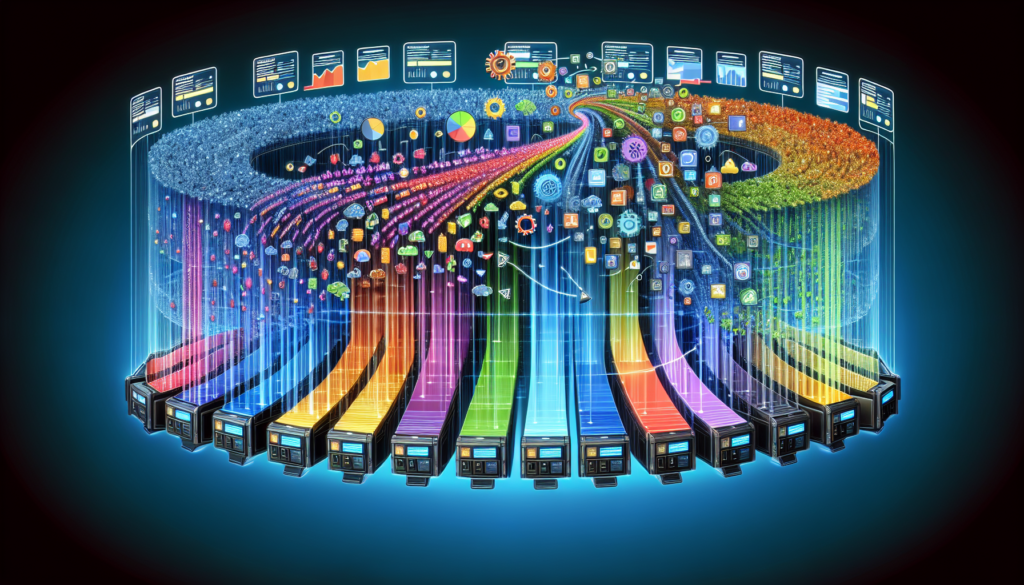When I first heard of LLM at the backend of 2022, I thought, here we go again with AI. At that point, it had been 18 years since I had coded for anything remotely related to AI, and having had my heart broken twice, I was not so sure I wanted to start all over again with Marketing and AI.
Over the last 19 months, I have joined the Generative bandwagon and find myself looking to the future of AI with a lot of trepidation and some joy.
During this period, I have worked with some of my clients and a small AI automation team to improve their productivity and do my best to communicate the simple fact that AI can improve the activities of individuals, but it can rarely replace them.
Below is a short guide to explore the top strategies we have used in AI marketing over the last 12 months. It will focus on seamlessly incorporating artificial intelligence into your digital marketing efforts. I will also demonstrate that by utilizing AI, businesses can automate operations, analyze extensive data sets, and personalize consumer interactions. Finally, I’ll show how implementing an AI marketing strategy helps refine marketing tactics and increase campaign efficiency.
Key Takeaways
AI marketing utilizes artificial intelligence technologies for data analysis and automated decision-making, improving the efficiency and effectiveness of digital marketing efforts for businesses of all sizes.
Essential AI marketing tools, such as machine learning algorithms, natural language processing, and predictive analytics, provide precise insights, real-time data processing, and targeted marketing strategies, leading to significant enhancements in the effectiveness of marketing campaigns. An AI marketing tool can be trained in customer preferences, external trends, and context, making it crucial for understanding and interpreting social listening data.
The advantages of AI marketing include improved customer personalization, enhanced campaign ROI, and quicker decision-making. However, the implementor must address data quality, privacy concerns, and stakeholder buy-in for successful implementation.
Understanding AI Marketing

AI marketing utilizes data analysis and automated decision-making to boost efficacy and streamline digital marketing activities. Essential functions of AI in marketing include gathering, analyzing, and leveraging insights from audience behavior to enhance workflows for superior outcomes. AI algorithms are used to analyze consumer data, creating personalized marketing campaigns while addressing ethical concerns and potential bias through audits, diversity in training data, transparency, and accountability measures. Within the dynamic domain of digital marketing, AI’s contribution is critical as it supports rapid choices and heightened productivity.
Marketing teams deploy a range of AI tools designed for tasks like:
-
-
- Assessing vast quantities of data
- Programmatic media procurement
- Creating content autonomously
- Customizing interactions in real-time
-
These AI writing tools are becoming increasingly vital for digital marketers.
AI-driven solutions are not only beneficial to large corporations but equally valuable to smaller enterprises looking to:
-
-
- Obtain a deep understanding of their target demographics
- Fine-tune their overall market approach
- Administer significant datasets with efficiency using AI platforms while gaining useful findings
- Strengthen existing promotional endeavors
-
Investments in artificial intelligence represent not just immediate benefits but also set up foundations for enduring business strategies.
By 2030, powered by advancements such as product development based on consumer information or hyper-personalized service offerings that shift buying behaviors, artificial intelligence-infused marketing will majorly contribute to economic expansion worldwide. Unearthing precise customer behavioral patterns and current marketplace directions through intelligent systems proves crucial when devising impactful promotion drives. Knowledgeable application across various facets, including predictive analytics automation or originality within creation, fosters the development of an effective strategy around AI technology usage within branding tactics.
Amidst this shifting terrain where targeted campaign methods evolve rapidly, the adaptability and success rates hinge increasingly upon harnessing advanced algorithms. AI offers strategies derived from pre-existing records coupled with new external influences. Thus, it holds monumental potential leverage points amongst specialized trade planners implementing machine learning-backed guidance operational sequences while continually adjusting to changing audience requirements and dynamics.
AI Marketing Tools

Selecting the appropriate AI marketing tools can significantly transform the marketing landscape. These AI tools are adept at:
-
-
- Swiftly sifting through large datasets
- Extracting vital information
- Analyzing said data
- Recommending optimal strategies for upcoming campaigns
-
They take over mundane tasks, liberating ai marketing teams to dedicate time to strategic planning and imaginative projects.
AI-powered digital marketing tools consolidate data handling and glean insights in one place, substantially increasing efficiency within a marketer’s workflow. AI tools enable marketers to:
-
-
- Enhance laborious processes of data analysis.
- Minimize errors in attribution analysis.
- Facilitate routine operations such as sorting through market data, addressing standard customer questions, and managing security clearances.
-
The AI tools directly boost organizational efficiency and employee productivity. Prominent among these AI-driven solutions are:
-
-
- Machine Learning technologies scrutinize historical metrics to refine future advertising efforts while crafting tailored content.
- Natural language processing (NLP) equips machines with an understanding of textual material, enhancing client interaction quality and improving written content.
- Predictive analytics forecast potential consumer behavior patterns and shifts in market dynamics, facilitating more precise ad targeting and polished tactics for forthcoming promotions.
-
Generative AI and Large Language Models (LLMs)

Generative AI pertains to AI systems that generate fresh content, like text, images, audio, or video, in response to prompts or queries. These systems learn patterns and structures from extensive datasets during training, enabling them to produce original outputs that replicate the characteristics of their training data. Essential features of generative AI include:
-
-
- Content creation: It can create diverse types of content, including written text, images, music, and even computer code.
- Learning from data: Generative AI models undergo training on large volumes of data to comprehend patterns and relationships within the data.
- Prompt-based generation: Many generative AI systems generate content based on user-provided prompts or instructions.
- Versatility: Generative AI finds applications across various domains, including art, writing, software development, product design, and scientific research.
- Underlying technology: Large Language Models (LLMs) and deep learning techniques, such as transformers, often power generative AI systems.
-
Large Language Models (LLMs) are specialized AI models created to understand and produce human-like text. They undergo training on extensive textual data, including books, articles, and online content, enabling them to learn the patterns and structures of language. LLMs excel at tasks such as text generation, language translation, and providing informative responses to queries. While LLMs focus on text generation as a subset of generative AI, generative AI models can generate a broad range of creative outputs. The critical distinctions between LLMs and generative AI are:
-
-
- Scope: LLMs concentrate on text-based tasks, while generative AI encompasses more content types.
- Applications: LLMs are best suited for natural language processing tasks, while generative AI is better suited for creative fields like art, music, and content creation.
- Data requirements: LLMs specifically operate with text data, while generative AI may necessitate diverse datasets for different types of content.
-
LLMs and generative AI have significant potential in diverse industries, including e-commerce, content creation, and customer service. They can enhance applications such as personalized content generation, multimodal content creation, and improved conversational AI.
Machine Learning Algorithms
ML algorithms are at the core of AI-driven marketing strategies, employing statistical techniques to parse through social data. They furnish finely tuned insights into audience feelings and experiences, along with other pivotal elements influencing marketing. This results in a richer comprehension of consumer tendencies and inclinations. Such algorithms bolster numerous aspects of marketing, such as research, customer support, content generation, and customization – making them essential tools for enhancing automation within the field. These machine learning systems are adept at rapidly carrying out complex tasks like text analysis, extracting topics, semantic groupings—in seconds—and even handling time-intensive aspect classification.
Incorporating semantic search mechanisms from machine learning enables marketers to efficiently identify crucial keywords organized into related groups or clusters, significantly refining the accuracy of created marketing material. Neural network models uniquely recall interlinked sets of data points. Their precision is heightened over time by engaging deep learning methods—resulting in continually improving outcomes as these networks learn from additional information they process. Their self-advancing nature renders them highly suitable for expanding business ventures.
It’s possible to craft bespoke content targeted precisely towards various buyer personas through personalized prompts derived using machine-learning technologies. When implemented strategically across different platforms, this vastly increases the potency and effectiveness of one’s promotional drives. By tapping into this advanced technology, brands can unearth deeper layers regarding consumer behavior and preferences, ensuring more intentional pinpointed actions intended specifically toward refining overall market endeavors.
Natural Language Processing (NLP)
Natural language processing (NLP) is a vital aspect of AI-driven marketing, allowing systems to parse and make sense of text. Within marketing, NLP facilitates tasks like Named Entity Recognition (NER), which pinpoints and sorts essential details from customer engagements into functional categories. This organization leads to deeper understanding and actionable intelligence. By leveraging NRP capabilities, chatbots and virtual agents can deliver tailored consumer interactions that elevate support services.
Regarding social media analytics, natural language processing utilizes sophisticated algorithms geared towards aspect clustering to sift through vast amounts of social data to unearth pertinent information. Sentiment analysis—an application within NLP—quantifies emotions contained in feedback, thereby aiding companies in monitoring their brand perception and decrypting consumer emotions more effectively through scrutinizing content such as survey responses, online critiques, and inbound communications both on the fly and retrospectively.
Applications powered by AI utilizing natural language processing include:
-
-
- Evaluation enhancement initiatives directed at boosting clarity for various communication materials, including email campaigns, blog posts, tweets, social media posts, and product endorsements
- The extraction of pivotal keywords plus motivators for crafting engaging narratives
- Improved efficiency when addressing client commentary
- A general upliftment in the caliber standards maintained across all forms created via marketing efforts
-
Predictive Analytics
Predictive analytics serves as an invaluable element in the toolkit of AI-enhanced marketing by allowing professionals to:
-
-
- Predict potential outcomes
- Craft specialized advertisements through extensive data analysis
- Make quicker, well-informed decisions
- Project market behaviors, product preferences, and sales projections with accuracy
- Extract crucial insights on consumer habits.
-
This analytical approach dissects large volumes of consumer data, empowering enterprises to fine-tune their marketing tactics.
Customer-led marketing solutions and AI marketing platforms combine to leverage predictive analytics for detailed segmentation and A/B testing that elevate campaign performance. Amazon effectively applies this technology for personalized product suggestions based on previous purchases and user activity—a strategy that bolsters customer experiences while boosting revenue. Employing predictive analytics affords marketers a distinctive vantage point from which they can more reliably predict client requirements and inclinations, thereby maintaining a competitive advantage.
Predictive analytics enhances customer retention processes through the following:
-
-
- Spotting customers who may be losing interest
- Engaging them with campaigns tailored for re-engagement
- Scrutinizing historical trends within datasets to discern patterns
- Evolving marketing techniques into more potent forms
- Assuring alignment between outreach endeavors and both public expectation & current industry dynamics,
-
All culminate in superior returns on investment (ROI) from these campaigns.
Types of AI Marketing Solutions

AI marketing solutions vary widely, from straightforward task automation to sophisticated machine learning applications. These solutions can be standalone applications or integrated into more prominent platforms, allowing businesses to choose the best fit for their needs. Standard AI marketing solutions include chatbots for customer engagement, programmatic advertising for real-time ad bidding, and dynamic pricing strategies to optimize revenue.
These AI-powered solutions offer significant benefits, enhancing customer experiences, optimizing operations, and delivering timely, personalized marketing messages. AI helps businesses improve their marketing and stay ahead of the competition.
Chatbots and Virtual Assistants
The new generation of chatbots and virtual assistants are AI-powered tools. Bots provide personalized customer support, streamline interactions, and offer the following benefits:
-
-
- Handle frequently asked questions
- Provide product recommendations
- Process orders
- Immediate and consistent responses to customer inquiries (The effectiveness and truth of response is directly dependent on the material on which the software was trained.)
- Answers to more nuanced questions
- Guide visitors through websites and sales funnels
- Enhance the overall user experience
-
Virtual assistants can handle all the above interactions and do even more. They can schedule appointments, handle customer calls, and provide personalized product recommendations.
These AI tools offer 24/7 availability, ensuring that customers receive support at any time without human intervention. Chatbots and virtual assistants enhance customer satisfaction and engagement by augmenting customer service agents, making them indispensable in modern marketing strategies.
Programmatic Advertising
Programmatic advertising leverages AI to automate the buying and selling of ads in real time. This process involves:
-
-
- Real-time bidding (RTB), where ads are bought and sold on an impression-by-impression basis
- Optimizing ad placements based on user data
- AI-driven programmatic advertising can target audiences more accurately by analyzing vast amounts of data
- Increasing ad effectiveness through precise targeting based on user behavior and demographics.
-
Utilizing machine learning algorithms allows programmatic advertisers to adapt marketing plans in real-time, bidding on ads relevant to the target audience based on various data points. This approach enhances marketing tactics by streamlining the selection process and setting up digital ads for maximum ROI.
Companies like Amazon employ AI for dynamic ad targeting, ensuring their messages reach the ideal audience precisely. This results in a more efficient and effective advertising strategy that drives higher engagement and conversion rates.
Particularly, with the Algorithms behind programmatic advertising, we have found the GIGO principle is at its most extreme. Some Algorithms are so off kilter that our clients have experienced up to 98% bounce rate.
Dynamic Pricing Strategies
Dynamic pricing strategies use AI to adjust prices based on market demand, competition, and customer behavior. AI algorithms analyze historical and competitive data to suggest optimal product prices in real-time, allowing businesses to maximize revenue. This approach enables continuous price optimization, ensuring companies remain competitive and responsive to market changes.
AI-driven dynamic pricing factoring in variables such as competitor prices, customer behavior, and seasonal trends offers personalized pricing based on individual customer data. For instance, Amazon uses AI to adjust prices in real-time based on demand, stock levels, and competitor prices, enhancing its competitive edge. Dynamic pricing strategies help businesses optimize revenue and improve customer satisfaction by offering fair and competitive prices.
For one of our art clients, we were able to bring together the experts from both spectrums (performing arts sales, and AI) to help them refine their pricing. This is nothing new, but unlike previous clients that would have needed to call consultants to repeat this interaction every two or three years, our client has the application in their back pocket and receives on going analysis of the consumer behavior towards their pricing strategy.

